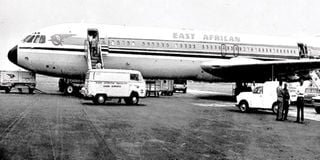Will carriers ever merge into a single African airline?

A plane belonging to East African Airways.
What you need to know:
- Are we likely to see African carriers come together? If they did, would it work?
Earlier this month, the African Airlines Association (AFRAA) held a webinar with stakeholders in the continent's aviation industry. It featured merger experts, bankers and executives of airlines including Ethiopian Airlines, Kenya Airways and Air Afrique.
Part of the discussion was the subject of consolidation of airline operations. This brings many opportunities such as improved networks, better service and greater bargaining or buying power with suppliers. Risks of consolidation include the cost and complexity of integrating technology and systems as well as customer dissatisfaction, as seen in the US.
This discussion comes after a tough 2020, in which 35 million passengers flew around Africa, which was 64 per cent lower than 95 million the year before the onset of Covid-19. As it is, aviation is not expected to get back to pre-Covid numbers till 2023.
Across the world, Covid-19 is seen as a likely catalyst for airline cooperation, taking different forms such as code shares, global alliances, joint ventures and acquisitions.
But are we likely to see African carriers come together? If they did, would it work?
A former executive of Air Afrique, which was owned by eleven West African countries after they gained independence, said the airline was a success. It lasted 41 years, had a larger network than its replacements but was killed by political interference.
Kenya Airways managing director Allan Kilavuka spoke about East African Airways which ran from 1946 to 1976. He said it was viable until the last five years when it was overstaffed, and plagued with distrust over unpopular political routes and revenue withheld by partner countries.
He emphasised that contrary to perception, African airlines such as in Kenya and Ethiopia do partner on maintenance and ground handling. A few days after the event, Kenya Airways, leased two Embraer planes to Congo Airways that will be flown by KQ staff for two years.
The challenges
Busera Awel, who was first chief executive at ASKY Airlines, seconded from its Ethiopian Airlines partner, spoke of the hub strategy they are pursuing in West Africa. From Lome in Togo, they serve 22 destinations that are largely fed by passengers from a daily Ethiopian Airlines flight from the New York area.
He said very few cities in Africa can produce 100 passengers on a flight per day and 50 is the right size for many routes.
As much as African airlines are growing, they carry only 20 per cent of the passengers flying around the region, and this is down from 60 per cent a few decades ago. Awel pointed out that unless airlines cooperate, they will not regain this market share.
However, he lamented that most African countries would rather partner with foreign airlines than with their fellow Africans. For instance, he notes that ASKY’s requests to access Dakar and Abidjan were unnecessarily delayed but the same rights were granted to Gulf carriers, adding that British managers in Ghana had no time to discuss partnership with him.
Other challenges to consolidation include unreasonable expectations by countries and state interference in management. Awel said he was often featured in West African newspapers for doing things like refusing to add government employees or delay flights.
From the AFRAA summit, one clear problem was that 54 countries want to regulate their own spaces, yet aviation is a cross-border industry whose rules should be harmonised.
Even before Covid-19, Africa has just 2 per cent of global air traffic and the lowest level of consolidations. The current state of aviation may finally force the implementation of the African Union’s Single African Air Transport Market (SAATM) project.





